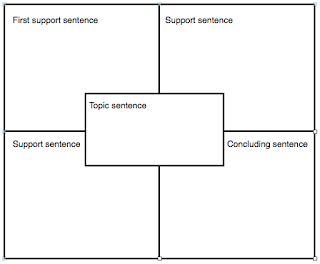Many students have trouble with writing paragraphs, let alone essays. For some, the difficulty lies in getting the ideas out of their heads and onto paper. There are too many things to think about all at once-- the ideas themselves, the words, the spelling, even the act of physically writing the letters can be an obstacle for some children. For others, the ideas are easy enough, but they tend to come out in a rambling, completely disorganized manner. Happily, both of these problems can be addressed.
For the first problem, that of expressing the ideas on paper, I have been most impressed by the techniques of Andrew Pudewa's Institute for Excellence in Writing (IEW). (And no, I have no stock in his company nor am I being compensated for mentioning it.) While some people whose children are blessed with a natural talent for writing might cringe at his methods and call them "formulaic" (or worse), there is a definite population of students who benefit from his carefully incremental approach. The child who sits and cries over his writing assignments, for whom writing three sentences is like pulling teeth, will find IEW a relief.
The problem for these students is that converting their thoughts into words feels like a Herculean task. They can speak just fine, but somehow slowing their brain down enough to translate thoughts into written sentences is near impossible. So IEW takes a step back, and has students first translate someone else's ideas into sentences. They begin by reading short paragraphs and making a "key word outline," choosing two or three of the most important words from each sentence. The student then creates a new sentence for each set of words. (In effect, he is also learning to take notes without plagiarizing!) Here is an example, using the paragraph I wrote above as the original text:
Of course, the vocabulary in my original paragraph is not suited to a young reader or writer, but I hope you get the idea. Once the student has had practice with writing key word outlines and turning them into new paragraphs, he is introduced to the idea of writing key word outlines from the information in his own head. The student is then not overwhelmed, because he is able to get all of his ideas down, a few words at a time, before going back to construct complete sentences. When this process has become easy, the student begins to add complexity to his sentences by adding "dress-ups," such as introductory phrases, precise nouns, verbs, adverbs and adjectives, and various sentence constructions.
Some students have no trouble at all writing complete sentences, but need help organizing them into a coherent paragraph. They may be used to typing away on a computer, and think creating an outline is an unnecessary step. The result is a disorganized mess. The concept of paragraph structure doesn't register at all.
There are many graphic organizers that are helpful for this. One very effective system was developed by J.S. and E.J. Gould, called the Four-Square Writing method. (No compensation here, either.) In this method, the paragraph is visualized as a block divided into sections, so that the topic sentence, supporting ideas and conclusion are presented as a unit. This not only helps the students to remember to include each element, but also helps them understand that all of the pieces work together.
Here is one example of a Four Square graphic organizer. Note that the topic sentence bar touches each of the other sections, and all of the sections together form a single square.
While the graphic organizer may be helpful on its own, the Goulds have developed a program of sequential lessons for various ages of students that help the students understand what makes a good topic sentence, how to write good supporting sentences, and how to conclude a paragraph without simply restating the topic sentence.
Here's an example of the organizer filled out with supporting details, topic and concluding sentences.
For the record, there is "mind-mapping" software such as FreeMind or SimpleMind that will guide a student through placing sentences in a graphic organizer, and then turn these words into an outline; these may be helpful for certain students. In my experience, however, I have not seen any such programs that get across the idea of paragraph cohesion to the same degree as the simple Four Square box. Once the student understands paragraph structure, the mind-mapping may be great, but until then it's just another tool to make his ramblings more complex.
Whether your student needs help getting the words on paper or just getting the words organized, the best approach is to start where he is and proceed at a comfortable pace. Slow and steady wins the race!



No comments:
Post a Comment